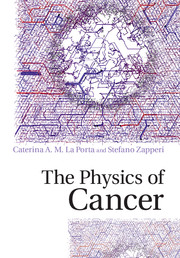Book contents
- Frontmatter
- Dedication
- Contents
- Preface
- 1 Introduction to the Cell
- 2 The Biology of Cancer
- 3 A Modeling Toolbox for Cancer Growth
- 4 Vascular Hydrodynamics and Tumor Angiogenesis
- 5 Cancer Stem Cells and the Population Dynamics of Tumors
- 6 Biomechanics of Cancer
- 7 Cancer Cell Migration
- 8 Chromosome and Chromatin Dynamics in Cancer
- 9 Control of Tumor Growth by the Immune System
- 10 Pharmacological Approaches: Old and New
- 11 Outlook on the Physics of Cancer: A New Interdisciplinary Area
- References
- Index
7 - Cancer Cell Migration
Published online by Cambridge University Press: 04 May 2017
- Frontmatter
- Dedication
- Contents
- Preface
- 1 Introduction to the Cell
- 2 The Biology of Cancer
- 3 A Modeling Toolbox for Cancer Growth
- 4 Vascular Hydrodynamics and Tumor Angiogenesis
- 5 Cancer Stem Cells and the Population Dynamics of Tumors
- 6 Biomechanics of Cancer
- 7 Cancer Cell Migration
- 8 Chromosome and Chromatin Dynamics in Cancer
- 9 Control of Tumor Growth by the Immune System
- 10 Pharmacological Approaches: Old and New
- 11 Outlook on the Physics of Cancer: A New Interdisciplinary Area
- References
- Index
Summary
Cell migration plays a fundamental role in cancer, being at the basis of the metastatic process, where cancer cells detach from the primary tumor, invade neighboring tissues and finally spread to distant organs. In this chapter we discuss the main biological and physical aspects of migration, starting from the motion of individual cells (Section 7.1) and the statistical characterization of their trajectories in terms of stochastic processes. Cells respond to chemical signals, in a process known as chemotaxis (Section 7.2), and then polarize and move in the direction of the chemical gradient. In order to move, cells make use of a vast class of cell adhesion molecules, which we review in Section 7.3.Motion results from the application of traction forces to the ECM, which can be quantified experimentally, as we discuss in Section 7.4. Cell adhesion molecules also play an important role in the interaction between cells, leading to collective effects. Experiments and models of collective cell migration are discussed in Section 7.5. Finally, in Section 7.6, all the fundamental steps giving rise to cell migration are summarized and discussed in the framework of the metastatic process.
Individual Cell Motion
Cell migration plays a key role in many physiological processes such as embryogenesis and morphogenesis, immune response, wound healing and tissue repair, but it is also a crucial determinant for cancer invasion and metastasis (Rørth, 2009; Friedl and Gilmour, 2009; Ilina and Friedl, 2009). Cellular migration is regulated at the biochemical level by the coordinated action of a multitude of factors involved in the response to external chemical stimuli, in the remodeling of the actin cytoskeleton and in the regulation of adhesion molecules needed to apply traction forces to the surrounding ECM and to neighboring cells. While discussing these processes in more detail in the coming sections, we focus here on the movement resulting from their integration.
- Type
- Chapter
- Information
- The Physics of Cancer , pp. 92 - 111Publisher: Cambridge University PressPrint publication year: 2017

